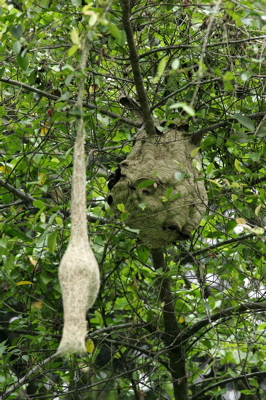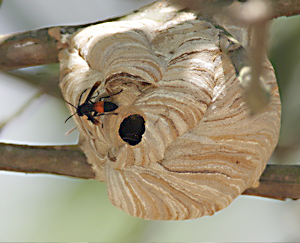Birds have been known to build their nests in close proximity to nests or hives of ants, bees and wasps. There is an advantage in such a relationship as the nesting birds are generally protected from predators, not so much by ants but more so by wasps.
A number of Baya Weaver (Ploceus philippinus) nests were recently seen high up the same tree where the lesser-banded hornets (Vespa affinia, Family Vespidae) have built their large nest (right). This nest, built from finely chewed fragments of wood mixed with saliva, has a typically papery appearance, thus it is sometimes known as paper wasp (below).
A social insect, the hornet has a distinct yellow banding on its first and second abdominal segments. It is also the most aggressive of the three species of hornets found in Singapore. It will attack with the slightest provocation and its sting is painful. The effect of the poison injected with the sting depends on the species and how sensitive the victim is to the poison. Response can be localized pain, swelling and redness. In more serious cases chest constriction, wheezing and vomiting may occur. Immediate medical attention is advisable.
Because of the poisonous nature of its sting and its inclination to attack at the slightest provocation, hornet gives perfect protection to the nesting weavers.
In a study in Ghana, it was shown that the Red-cheeked Cordonbleu (Uraeginthus bengalus) benefited by nesting near the wasp Ropalidia cincta. The chicks of these birds were twice as likely to fledge as those that nest in trees without wasps. Reduced predation was apparently a major reason for increased fledging success. There were four cases of nest predation on 122 Red-cheeked Cordonbleu nests associated with wasps, and 11 cases on 90 nests not associated with wasps.
Text by YC Wee, images by Chan Yoke Meng, wasp identification by Prof Cheong Loong Fah
References:
Beier, P. & Tungbani, A. I. (2006). Nesting with the wasp Ropalidia cincta increases nest success of Red-cheeked Cordonbleu (Uraeginthus bengalus) in Ghana. The Auk 123(4):1022-37.
Gopalakrishnakone, P. (ed.) (1990). A colour guide to dangerous animals. Singapore University Press.











4 Responses
Since the hornets are so agressive, will they not attack the Baya weavers & the chicks?
On a bush walk today we were moving a fallen branch that shook the hornet’s nest (unbeknownst to us) and then I heard this buzzing like a humming bird. Next thing a hornet hits my head and stings me on the top of the head in one swoop. It flew off then came back for another swoop on my hiking partner. He didnt get stung – luckily for him.
Its now 9hrs since the sting and it still hurts like hell. These guys are aggressive and they sting aint fun. Its not super painful, but it just doesnt stop. It hurts now just as much as it did when I got hit.
OUCH!
Steer clear of these nexts at all costs!!!!